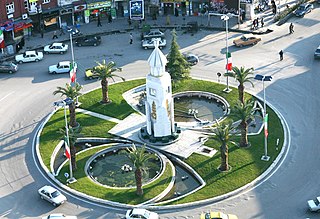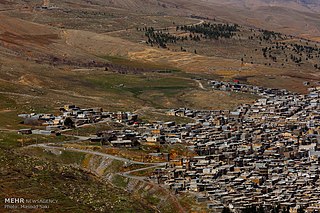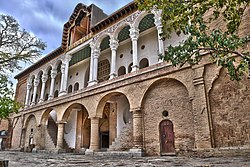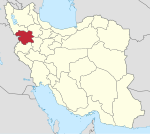
Gorgan is a city in the Central District of Gorgan County, Golestan province, Iran, serving as capital of the province, the county, and the district. It lies approximately 400 km (250 mi) to the northeast of the national capital Tehran, and some 30 km (19 mi) away from the Caspian Sea.

Azna is a city in the Central District of Azna County, Lorestan province, Iran, serving as capital of both the county and the district.

Pol-e Dokhtar is a city in the Central District of Pol-e Dokhtar County, Lorestan province, Iran, serving as capital of both the county and the district.

Shahr-e Kord is a city in the Central District of Shahrekord County, Chaharmahal and Bakhtiari province, Iran, serving as capital of the province, the county, and the district. It is the largest city in the province, and is 90 km away from Iran's third largest city, Isfahan. Shahr-e Kord is populated by Persians, Lurs and Turkic people.
Sonqor is a city in the Central District of Sonqor County, Kermanshah province, Iran, serving as capital of both the county and the district. It is in the Zagros Mountains, about 90 kilometers from the province's capital city Kermanshah, and consists of two valleys; that of Gavehrud and Shajarud. Sonqor lies between the modern cities of Kangavar and Sanandaj.

Gonbad-e Kavus is a city in the Central District of Gonbad-e Kavus County, Golestan province, Iran, serving as capital of both the county and the district.

Ardalan was a hereditary Kurdish vassaldom in western Iran from around the 14th century until 1865 or 1868 with Sanandaj as capital. The territory corresponded roughly to present-day Kurdistan Province of Iran and the rulers were loyal to the Qajar Empire. Baban was its main rival. Gorani was the literary language and lingua franca. When the vassaldom fell, literary work in Gorani ceased.
Baneh is a city in the Central District of Baneh County, Kurdistan province, Iran, serving as capital of both the county and the district. Baneh is approximately 30 km from Kurdistan Region in Iraq.

Mah Sharaf Khanom Mastoureh Ardalan or Mastura Ardalan was a Kurdish poet, historian, and writer.

Qaem Shahr is a city in the Central District of Qaem Shahr County, Mazandaran province, Iran, serving as capital of both the county and the district. Originally known as Aliyabad, the name Ŝâhi (Shahi) was used until the Iranian Revolution in 1979 when the city acquired its current name.

Firuzkuh is a city in the Central District of Firuzkuh County, Tehran province, Iran, serving as capital of both the county and the district.
Aleshtar is a city in the Central District of Selseleh County, Lorestan province, Iran, serving as capital of both the county and the district. The city is populated by Kurds.
Nurabad is a city in the Central District of Delfan County, Lorestan province, Iran, serving as capital of both the county and the district.

Sonqor County is in Kermanshah province, Iran. Its capital is the city of Sonqor.

Ahar is a city in the Central District of Ahar County, East Azerbaijan province, Iran, serving as capital of both the county and the district. Ahar was the capital of Karadag Khanate in 18th and 19th centuries.

Dorud is a city in the Central District of Dorud County, Lorestan province, Iran, serving as capital of both the county and the district.
Sahand is a city in the Central District of Osku County, East Azerbaijan province, Iran.
Zarrinnaal or Zarrin Naal is the name of a dynasty of Kurdish tribal chiefs and state officials belonging to the Zarrin Kafsh tribe and originated from Sanandaj in Kurdistan Province of Iran. Their heads with the title of Beyg, Beyk or Beg (lit."lord") were the Aghas of Senneh and ruled their fiefdom during the time of four hundred years when the Safavids, Afsharids and finally Qajar dynasty reigned in Iran.
Zarrin Kafsh also Zarrinkafsh is the name of a Kurdish tribe in Kurdistan Province of Iran which took part in the history of the Iranian Kurdistan Province especially the city of Sanandaj under the rule of the Ardalan princes. The families of Zarrinnaal and Zarrinkafsh belong to this tribe.
Qara Kheyl is a village in Balatajan Rural District of the Central District of Qaem Shahr County, Mazandaran province, Iran.



















